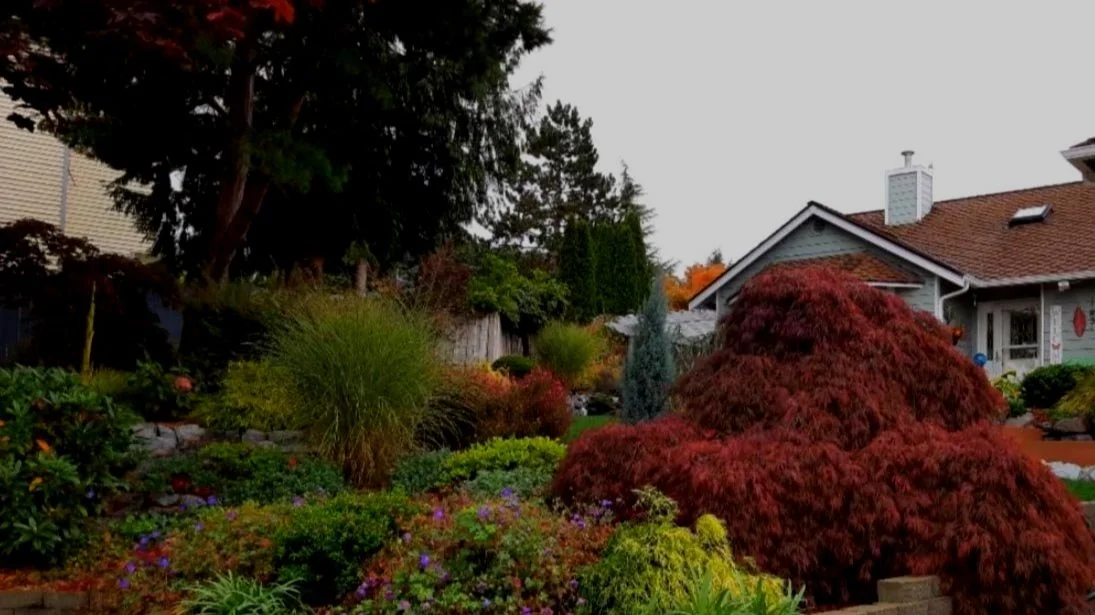As I drive home each day and gaze upon landscape after landscape (including my own of course), I tend to wonder many things… When will that homeowner decide to cut back those grasses? Who will clean all the brown, old growth out of that dwarf conifer? How could they leave that poor broadleaf evergreen with fallen foliage smothering its leaves? Will someone please tidy up that lace leaf maple that is still covered in last year’s fallen foliage? Please do not think of me as judgmental, but these are the questions to which a gardener like me simply needs the answers.
I personally struggle with this topic in my own yard, winter after winter. My OCD side likes not one fallen leaf, twig or cone distracting from my immaculately mulched slice of heaven. The lawn cannot have such clutter either – that would be uncivilized! My logical half (like many of you, I am sure) screams back “Mother Nature gives us these wonderful things to HELP our gardens!” Absolutely true. I have gotten better about all of this over the years, and of course there is no golden rule to follow in any landscape. But, to focus on the facts, our plants (and lawns) need light and air circulation, especially given our northern latitude, lack of winter sunshine, and excessive moisture.
So let's start there, moisture, lack of sunshine, and poor air circulation – all of which can lead to disease. Leaving old foliage that covers the tops of evergreen plants is never a good thing. All it takes is a gentle shake and massage to eradicate all of that foliage smothering the plant. If left on, fallen foliage will choke out the sun and cause browning of healthy leaves and/or cause unwanted dieback. Let your little beauties breathe please! All this debris makes wonderful mulch to suppress weeds with and helps to protect root systems and plants on the ground, eventually adding nutrients and energizing soil microbes as it decomposes.
Next up, let’s talk slugs and bugs. Old leaves, whether clinging in branches of shrubs or smothering the crowns of perennials at ground level, are not always ideal in my opinion. This OCD gardener will never change when it comes to getting all the debris out of the shrubs and trees, but ground level debris is the debate now. These ground areas are the places that slugs can leave eggs to hatch the coming spring or harmful insects can find a hiding place over the winter. On the other hand, hummingbirds like some protein in the winter (bugs from the yard) as well as many of our other feathered friends. Leaves do make wonderful mulch and will add to your soil composition year after year. But there are many plants that stubborn PNW gardeners like me have that are prone to slugs. Try cleaning around some of these a little more diligently, perhaps making them less welcome to slugs and bugs in the winter. You can also add some good organic slug control (Iron Phosphate products, like Sluggo) around prone plants in late winter to add even more protection. Getting ahead in the battle against slugs and bugs is always beneficial come springtime.
One more point to ponder on fallen foliage… Was that specimen healthy last season? Or, for example, was it a rose with mildew or a dogwood with anthracnose? Foliage that has fallen off diseased plants should absolutely be cleaned up or you are asking for the same issue to come back the following spring. In these instances, go OCD like me and pick them up and dispose of them in the yard waste.
Now go out, survey your personal gardening kingdom and find your own balance between neat and natural. If by chance I drive by your home, I promise not to judge or leave a note on the door.
Trevor Cameron is a Certified Professional Horticulturist (CPH) and serves as General Manager for Sunnyside Nursery in Marysville, WA. He can be reached at sunnysidenursery@msn.com



